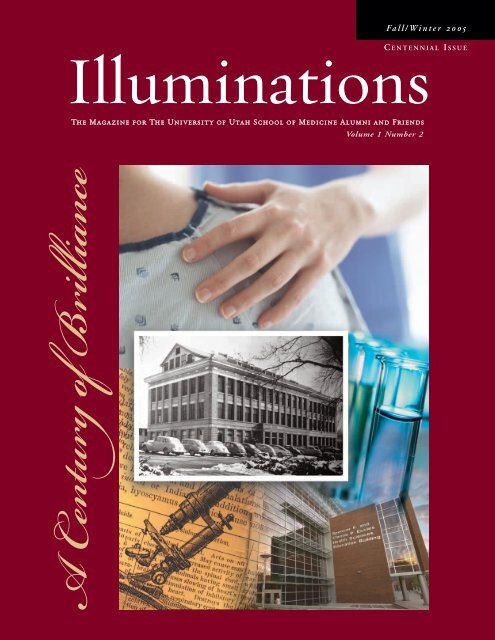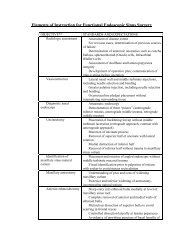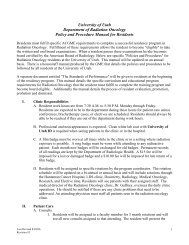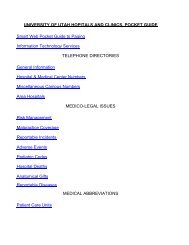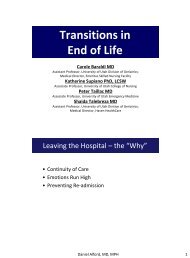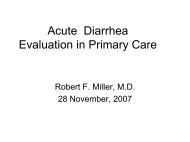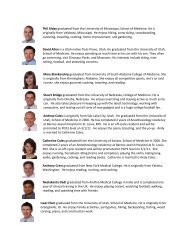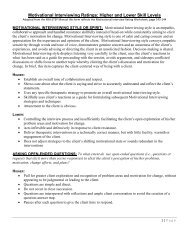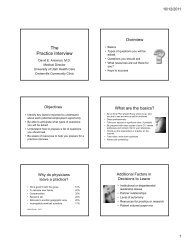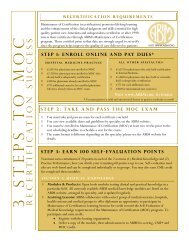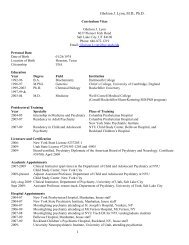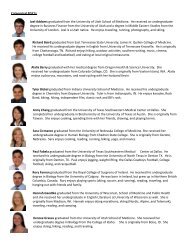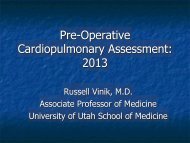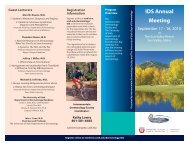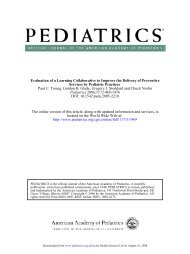2005 Centennial Issue - University of Utah - School of Medicine
2005 Centennial Issue - University of Utah - School of Medicine
2005 Centennial Issue - University of Utah - School of Medicine
You also want an ePaper? Increase the reach of your titles
YUMPU automatically turns print PDFs into web optimized ePapers that Google loves.
A Centu <strong>of</strong> Billiance<br />
C ENTENNIAL ISSUE<br />
Illuminations<br />
The Magazine for The <strong>University</strong> <strong>of</strong> <strong>Utah</strong> <strong>School</strong> <strong>of</strong> <strong>Medicine</strong> Alumni and Friends<br />
Volume 1 Number 2<br />
Fall/Winter <strong>2005</strong>
Illuminations<br />
The Magazine for The <strong>University</strong> <strong>of</strong> <strong>Utah</strong> <strong>School</strong> <strong>of</strong> <strong>Medicine</strong> Alumni and Friends<br />
Editor<br />
KRISTIN LISZKOWSKI-DEAN<br />
Contributors<br />
David Bjorkman, M.D.<br />
Richard E. Black, M.D.<br />
John Edwards,<br />
Public Affairs,<br />
<strong>University</strong> Health Sciences<br />
Thomas H. Caine, M.D.<br />
Jocelyn Kearl<br />
Fred F. Langeland, M.D.<br />
James L. Parkin, M.D.<br />
Photography<br />
UNIVERSITY MEDICAL GRAPHICS<br />
Illuminations<br />
is published by the<br />
<strong>University</strong> <strong>of</strong> <strong>Utah</strong><br />
<strong>School</strong> <strong>of</strong> <strong>Medicine</strong><br />
Alumni Relations Office<br />
For editorial information or corrections,<br />
call (801) 585-3818<br />
Send address changes to:<br />
Illuminations<br />
<strong>School</strong> <strong>of</strong> <strong>Medicine</strong><br />
Office <strong>of</strong> Alumni Relations<br />
540 South Arapeen Drive<br />
Suite 125<br />
Salt Lake City, <strong>Utah</strong> 84108-1298<br />
WHAT’S INSIDE:<br />
1 Message from the Dean<br />
2 Alumni President’s<br />
Message<br />
3 History & Achievements<br />
<strong>University</strong> <strong>of</strong> <strong>Utah</strong> <strong>School</strong> <strong>of</strong> <strong>Medicine</strong> Alumni Association<br />
Board <strong>of</strong> Directors<br />
Fred F. Langeland, M.D., 1976, President<br />
Thomas H. Caine, M.D., 1963, Past President<br />
Richard E. Black, M.D., 1974, Vice President<br />
Swen R. Swenson, M.D., House Staff, 1967, Secretary<br />
Dominic Albo, Jr., M.D., House Staff, 1968<br />
Richard S. Boyer, M.D., 1973<br />
C. Hilmon Castle, M.D., House Staff, 1957<br />
Brent J. Christensen, M.D., 1984<br />
Kent W. Farnsworth, M.D., 1971<br />
Beth C. Hanlon, M.D., 1991<br />
Janet K. Harnsberger, M.D., 1981<br />
Robert O. H<strong>of</strong>fmann, M.D., 1981<br />
Mark A. Johnston, M.D., 1990<br />
August “Larry” Jung, M.D., 1961<br />
Viet Nguyen, M.D., 1997<br />
James L. Parkin, M.D., 1966<br />
Richard R. Price, M.D., 1960<br />
Ronald J. Ruff, M.D., 1981<br />
Hugh D. Voorhees, M.D., 1972<br />
Homer R. Warner, M.D., 1949<br />
Daren A. Watts, M.D., House Staff, 2001<br />
Hugh S. West, Jr., M.D., 1985<br />
10 Medical Alumni Hall<br />
12 Alumni Weekend <strong>2005</strong><br />
Recap<br />
16 Distinguished Alumni<br />
& Distinguished<br />
Service Awards <strong>2005</strong><br />
17 Honoring Excellence<br />
18 Student Life<br />
19 Alumni Memories<br />
21 Hurricane Relief Efforts<br />
Ex Officio:<br />
Stephen Warner, Assistant VP <strong>of</strong> Health Sciences<br />
for Development & Alumni Relations<br />
David Bjorkman, Dean, M.D., M.S.P.H., 1980<br />
Kristin Liszkowski-Dean, Director<br />
Student Representatives:<br />
Thurston Drake, MS II, 2008<br />
Alvin Kwok, MS IV, 2006<br />
Karly Pippitt, MS IV, 2006<br />
Jody Quick, MS II, 2008<br />
22 A Condensation <strong>of</strong><br />
“The Untapped Power<br />
<strong>of</strong> the Pr<strong>of</strong>ession”<br />
24 We Want to Hear from You<br />
25 In Memoriam
Dean David Bjorkman, M.D., M.S.P.H., 1980<br />
Opening this new building seems an<br />
appropriate celebration <strong>of</strong> the one<br />
hundredth anniversary <strong>of</strong> the founding<br />
<strong>of</strong> the <strong>School</strong> <strong>of</strong> <strong>Medicine</strong>. I am<br />
sure that those fourteen students<br />
who enrolled in a two-year medical<br />
program in a building on President’s<br />
Circle would be astounded by the<br />
current teaching space. Those physicians<br />
who practiced and trained at<br />
the old Salt Lake County Hospital in<br />
the early days <strong>of</strong> our four-year medical<br />
program are equally impressed<br />
by the expansion <strong>of</strong> our clinical<br />
facilities. The new Eccles Critical<br />
Care Pavilion, the Huntsman Cancer<br />
Hospital, the <strong>University</strong> Orthopedic<br />
Center, and the new Moran Eye<br />
Center (under construction) represent<br />
the greatest expansion <strong>of</strong> our<br />
clinical facilities in our history.<br />
When the Emma Eccles Jones<br />
Research Building opens this year it,<br />
along with extensive renovations <strong>of</strong><br />
laboratories in Research Park, will<br />
provide a similar expansion <strong>of</strong> our<br />
research space.<br />
Message from the Dean<br />
For the first time our medical students are attending classes in the new<br />
Spencer F. and Cleone P. Eccles Health Sciences Education Building. This 158,000 square-<br />
foot building has larger classrooms that provide state-<strong>of</strong>-the-art capabilities for education.<br />
It also has outstanding clinical and laboratory teaching areas. The classrooms replace the old<br />
classrooms A through D that have been used for medical student classes since the old hospital<br />
was constructed in 1965. After forty years, we now have the best and most up-to-date teaching<br />
facilities in the country.<br />
From the humble beginnings on<br />
President’s Circle in 1905, the<br />
<strong>University</strong> <strong>of</strong> <strong>Utah</strong> <strong>School</strong> <strong>of</strong><br />
<strong>Medicine</strong> has grown to be an<br />
internationally recognized center<br />
<strong>of</strong> excellence in clinical care,<br />
research, and education. The<br />
<strong>School</strong> <strong>of</strong> <strong>Medicine</strong> has a budget<br />
<strong>of</strong> $475 million this year to carry<br />
out our missions. We have 411<br />
medical students, 630 residents<br />
and fellows in training, and 450<br />
graduate students seeking advanced<br />
degrees. <strong>University</strong> Healthcare<br />
facilities are found throughout the<br />
Wasatch Front providing access for<br />
the state’s population.<br />
I recall the <strong>School</strong> <strong>of</strong> <strong>Medicine</strong> when<br />
I graduated in 1980. The current<br />
<strong>University</strong> Hospital was a large hole<br />
in the ground. The anatomy laboratory<br />
was in a barracks built on the<br />
side <strong>of</strong> the mountain during World<br />
War II. There was no Eccles Genetics<br />
Building, no Wintrobe Building,<br />
and no Biopolymers Building. Even<br />
then I was proud to be recognized<br />
as an alumnus <strong>of</strong> one <strong>of</strong> the best<br />
medical schools in the country.<br />
Like thousands <strong>of</strong> other graduates I<br />
gained the knowledge and skills that<br />
have allowed me to treat thousands<br />
<strong>of</strong> patients over the last 25 years. I<br />
have always been proud that I can<br />
1<br />
list the <strong>University</strong> <strong>of</strong> <strong>Utah</strong> <strong>School</strong> <strong>of</strong><br />
<strong>Medicine</strong> in my credentials.<br />
As we recognize this centennial year<br />
we celebrate the century <strong>of</strong> progress<br />
in education, patient care, and<br />
research that has occurred in our<br />
<strong>School</strong>. We should also celebrate the<br />
bright future that we face with our<br />
new facilities. I am confident that<br />
the next century will be even more<br />
remarkable than the last. We cannot<br />
predict what the <strong>School</strong> <strong>of</strong> <strong>Medicine</strong><br />
will look like decades in the future,<br />
but I can assure you that the tradition<br />
<strong>of</strong> excellence will continue.<br />
David Bjorkman, M.D., M.S.P.H., 1980<br />
Dean<br />
<strong>University</strong> <strong>of</strong> <strong>Utah</strong> <strong>School</strong> <strong>of</strong> <strong>Medicine</strong>
Everyone associated with the Health Sciences Center is aware <strong>of</strong> the 100-year anniversary<br />
<strong>of</strong> the <strong>School</strong> <strong>of</strong> <strong>Medicine</strong>. The Medical <strong>School</strong> began as a two-year institution a century ago, and this year we<br />
have had numerous activities celebrating this landmark event.<br />
As part <strong>of</strong> the Alumni Weekend in June, our annual CME Conference focused on the history <strong>of</strong> the Medical<br />
<strong>School</strong>. Several <strong>of</strong> our “Pioneers <strong>of</strong> <strong>Medicine</strong>” returned to speak on the growth we have experienced within their<br />
respective specialties. Dr. George Veasy, who was instrumental in building Primary Children’s Medical Center<br />
into the world renowned facility that it is, spoke on the history <strong>of</strong> the <strong>School</strong> <strong>of</strong> <strong>Medicine</strong>. Dr. Russell M. Nelson<br />
related his experiences in helping to develop the heart bypass machine and in doing the first open-heart surgery<br />
in <strong>Utah</strong>. Dr. Homer Warner spoke on his development <strong>of</strong> the first medical informatics department in <strong>Utah</strong>, and<br />
in the country for that matter. Dr. Lawrence Stevens talked about doing the first kidney transplant in <strong>Utah</strong>.<br />
And, Dr. Larry Jung spoke on establishing the first newborn ICU in the state.<br />
This year the new Spencer F. &<br />
Cleone P. Eccles Health Sciences<br />
Education Building opened and<br />
students have a wonderful new<br />
center to enjoy as they learn the<br />
science <strong>of</strong> medicine. The Alumni<br />
Association contributed close to<br />
$150,000 towards its construction<br />
and has an auditorium named in<br />
our honor called “Alumni Hall.” We<br />
want to extend a special thanks to all<br />
those who generously contributed to<br />
that hall. We encourage you to visit<br />
the Education Building and witness<br />
for yourself that magnificent facility.<br />
Our students are fortunate to have<br />
such a pleasant, modern, high-tech<br />
center for learning, and we as alumni<br />
can surely be proud to be a part <strong>of</strong> its<br />
completion. The environment within<br />
its walls is so enticing that it almost<br />
makes me want to go back to school.<br />
As we look back on the history <strong>of</strong> our<br />
institution, it is natural to reflect on<br />
our own experience as we began our<br />
careers in medicine. When I arrived<br />
for my first day <strong>of</strong> class in the fall <strong>of</strong><br />
1972, I was awestruck to be in such a<br />
prestigious school studying my life’s<br />
dream. Our campus was a far cry<br />
from the old county complex on 21st<br />
South. Yet, the new hospital had not<br />
yet been built nor had the Huntsman<br />
Cancer Institute, the Moran Eye<br />
Alumni President’s Message<br />
Center, the new Primary Children’s<br />
Medical Center, the new Eccles<br />
Critical Care Pavilion, or the new<br />
Spencer F. & Cleone P. Eccles Health<br />
Sciences Education Center. Even<br />
AirMed was not yet in existence.<br />
By today’s standard, with all the<br />
marvelous additions to our campus,<br />
what we had to work with 30 years<br />
ago might seem rather archaic. On<br />
the other hand, we were blessed<br />
with legendary pr<strong>of</strong>essors such as<br />
Dr. Hashimoto, who could draw<br />
the human body with both hands<br />
simultaneously and effortlessly. Who<br />
could forget Dr. Wintrobe whose<br />
demand for excellence inspired our<br />
desire for perfection? Then there was<br />
Dr. Goodman and his “Blue Bible”<br />
who taught us “the dose <strong>of</strong> the<br />
drug is enough!” I also can’t forget<br />
Dr. Frank Tyler and his thoughtful<br />
retreats for students and residents at<br />
his log cabin home. I remember well<br />
Dr. Lou Samuels with his cheery<br />
disposition who taught us to understand<br />
and respect the laboratory.<br />
Space does not permit mention <strong>of</strong> all<br />
those pr<strong>of</strong>essors who were so instrumental<br />
in helping our class become<br />
physicians, but I am grateful for their<br />
training and interest in me. I suspect<br />
that in another decade, our current<br />
students will look back with the same<br />
2<br />
fondness and reverence for our current<br />
faculty who are fast becoming<br />
“legends <strong>of</strong> medicine.”<br />
Though the science and technology<br />
<strong>of</strong> medicine has progressed over the<br />
past three decades, some things will<br />
always be the same. <strong>Medicine</strong> will<br />
always involve interested, sensitive,<br />
well-trained pr<strong>of</strong>essionals giving the<br />
best health care available. Despite<br />
new drugs, procedures, and changing<br />
techniques, the doctor-patient relationship<br />
will always remain. For me,<br />
that is what makes medicine such a<br />
special pr<strong>of</strong>ession.<br />
We as a committee appreciate all the<br />
support the alumni give whether it<br />
be personally, as in the mentoring<br />
program, or at various activities,<br />
or through financial support <strong>of</strong> the<br />
school and the Alumni Association.<br />
We also encourage any suggestions<br />
you may have to improve the<br />
Alumni Association and its mission<br />
to support the <strong>School</strong> <strong>of</strong> <strong>Medicine</strong><br />
its alumni, faculty and students.<br />
Fred F. Langeland, M.D., 1976<br />
President, Alumni Board<br />
<strong>University</strong> <strong>of</strong> <strong>Utah</strong> <strong>School</strong> <strong>of</strong> <strong>Medicine</strong><br />
Alumni Association<br />
Fred F. Langeland, M.D., 1976
UNIVERSITY OF UTAH<br />
Histor<br />
SCHOOL OF MEDICINE<br />
& Achievements<br />
1905-<strong>2005</strong> In 1972, Dr. John Dixon, Vice President for Health Sciences at the <strong>University</strong> <strong>of</strong> <strong>Utah</strong>, stated,<br />
“<strong>Utah</strong> has no business having a medical school in the state, absolutely no<br />
business from a fi nancial standpoint or a clinical standpoint. We just can’t justify it,<br />
let alone a medical school that I think is one <strong>of</strong> the top fi fteen in the U.S. We only<br />
deserve a third-rate, under-fi nanced, trade-school operation, and what we have is a<br />
fi rst-rate, research-oriented health sciences group… a tribute to all<br />
those who have gone before me.”<br />
In the beginning <strong>of</strong> the 20th century there was no sprawling<br />
Health Sciences Center on campus—just the John R. Park Building and some<br />
adjacent structures near the Park Building circle. And, the U.S. Army Post,<br />
Fort Douglas, was nestled in the foothills where the health sciences now thrive.<br />
James E. Talmage Building, originally<br />
built as a museum in 1902, located on<br />
Presidents Circle. It housed the medical<br />
school from 1905 to 1920.<br />
One hundred years ago,<br />
in 1905, the medical school at the<br />
<strong>University</strong> <strong>of</strong> <strong>Utah</strong> was born. As Dr. Dixon<br />
stated, <strong>Utah</strong> did not have the funding nor the<br />
talent to start such an academic institution.<br />
Nevertheless, from its humble beginnings,<br />
a world-class Medical <strong>School</strong> has been built<br />
thanks to the brilliance, talent, and hard work<br />
<strong>of</strong> hundreds <strong>of</strong> physician-educators, students,<br />
and administrators. A brief review <strong>of</strong> the history<br />
<strong>of</strong> <strong>Utah</strong>’s <strong>School</strong> <strong>of</strong> <strong>Medicine</strong> reveals spectacular<br />
accomplishments on community, national,<br />
and international stages. Drs. Max Wintrobe,<br />
George Cartwright, Leonard Jarcho, Val Jaeger,<br />
Frank Tyler, William Harris, Lyman Fulton,<br />
Hans Hecht, Edward Hashimoto, Ewart<br />
Swinyard, Louis Goodman, Leo Samuels, and<br />
scores <strong>of</strong> others helped<br />
instill rigor and excellence<br />
into the medical school.<br />
Others have picked up the<br />
torch and are running with<br />
it today as the tradition <strong>of</strong><br />
excellence continues.<br />
one unded eas
the stater ome<br />
LeRoy Cowles Building<br />
on President’s Circle. The<br />
<strong>School</strong> <strong>of</strong> <strong>Medicine</strong> had its<br />
beginnings on the second<br />
fl oor <strong>of</strong> the U <strong>of</strong> U Museum<br />
in 1904.<br />
1909 Entrance requirements<br />
established. Students must have<br />
one year <strong>of</strong> college work, including<br />
physics, inorganic chemistry, zoology<br />
or comparative anatomy, qualitative<br />
analysis, and a reading knowledge <strong>of</strong><br />
French or German.<br />
1924 Premedical requirements<br />
increased from one to three years<br />
<strong>of</strong> college.<br />
1927 Since the <strong>University</strong> <strong>of</strong><br />
<strong>Utah</strong>, until 1942, was only a two-<br />
year medical school, students<br />
needed to obtain their last two years<br />
<strong>of</strong> schooling elsewhere. The following<br />
quote from the December 9th<br />
Chronicle showed they did very well,<br />
“All students that have transferred<br />
to Harvard Medical <strong>School</strong> stood in<br />
the upper third to upper one-tenth<br />
<strong>of</strong> their classes, and similar reports<br />
are coming from other institutions.<br />
Students from the <strong>University</strong> <strong>of</strong><br />
<strong>Utah</strong> lead all other groups who have<br />
transferred to the <strong>University</strong> <strong>of</strong><br />
Pennsylvania.”<br />
1909 Medical<br />
Department removed<br />
from College <strong>of</strong> Arts<br />
and Sciences when<br />
accreditation teams<br />
demanded it.<br />
beginnings<br />
1929 The Department <strong>of</strong> Biochemistry<br />
was formed and placed in a converted attic.<br />
1942 In September the school<br />
had $150 left in the budget and staff<br />
consisted <strong>of</strong> one “effi cient secretary,<br />
1905-1942<br />
1905-06 Two-year medical course begins in the Department <strong>of</strong><br />
Biology. Fourteen students enrolled, all <strong>of</strong> whom became physicians.<br />
1907 An ill-fated two-year experiment began, placing the<br />
Medical Department in the College <strong>of</strong> Arts and Sciences.<br />
1907 Legislature passed a law that<br />
“unclaimed dead bodies <strong>of</strong> convicts and<br />
other persons” be provided to the medical<br />
school for instructional purposes.<br />
1942 In May, Board <strong>of</strong> Regents<br />
approves four-year medical school.<br />
1942 In July, a contract is drawn between<br />
the <strong>University</strong> and Salt Lake County Hospital.<br />
1909 ROTC barracks, built to train cavalry<br />
<strong>of</strong>fi cers, became the medical school central facility<br />
for the next 40 years.<br />
1939 Working through the WPA, and at a cost <strong>of</strong><br />
$35,000, the only expansion <strong>of</strong> the medical building<br />
in 20 years was completed.<br />
Mrs. Florence Strong.” 1942 Dr. Louis P. Gebhardt,<br />
Students train in physical diagnosis skills in the 1940s.<br />
Salt Lake County General Hospital<br />
4<br />
hired from Stanford <strong>University</strong><br />
to head the Department <strong>of</strong><br />
Bacteriology, is dismayed at what<br />
he fi nds. “The lab looked like the<br />
stone-age variety. There were<br />
only two cultures and both were<br />
contaminated.” He admitted to<br />
having to collect 400 mice, steal<br />
cages to house them, and then<br />
having half die the fi rst night<br />
because the labs weren’t heated.
1942 Also in July, Dr. Cyril Callister,<br />
noted plastic surgeon, is named the fi rst<br />
Dean <strong>of</strong> the four-year school.<br />
1949 <strong>School</strong> began accepting students<br />
from Idaho, Nevada, and Arizona, under<br />
a plan in which the states would pay their<br />
students’ tuition.<br />
1949 Sloan Kettering<br />
Institute’s Dr. Rulon Rawson<br />
ranked <strong>Utah</strong> in the top ten<br />
medical schools in the nation.<br />
1943 To increase faculty,<br />
“downtown” doctors were<br />
hired at $1 per year and<br />
for the increased prestige<br />
that association with the<br />
<strong>University</strong> Medical <strong>School</strong><br />
would bring.<br />
1945 The medical school gets<br />
its fi rst big grant–$100,000 from<br />
Congress for research.<br />
“The Bloodshed”—This barracks building<br />
on the Salt Lake County General Hospital<br />
grounds was fondly known by its intimates as<br />
the bloodshed because <strong>of</strong> the hematology research<br />
conducted there by Maxwell M. Wintrobe,<br />
M.D., Ph.D., George E. Cartwright, M.D.,<br />
and others.<br />
Louis S. Goodman, M.D.,<br />
1951 Building for cancer research opens. distinguished pr<strong>of</strong>essor <strong>of</strong><br />
pharmacology.<br />
triumphs<br />
1955 Medical <strong>School</strong> receives<br />
$1.5 million from the United<br />
States Public Health Services.<br />
1955 Business report<br />
states that every $1 invested<br />
in the medical center generates<br />
$3.10 revenue for the<br />
state <strong>of</strong> <strong>Utah</strong>. In <strong>2005</strong>, it is<br />
over $9 for every $1.<br />
1942-1955<br />
Edward I. Hashimoto, M.D.<br />
1946 To improve care at the Veterans<br />
Administration Hospital, informal rotations<br />
for students, interns, and residents were<br />
established with the Medical <strong>School</strong>.<br />
1948 Medical <strong>School</strong> receives $416,400 to study cancer.<br />
1953 75 full-time and 220 part-time faculty.<br />
An exacting taskmaster—medicine patient rounds<br />
with Maxwell M. Wintrobe, M.D., Ph.D.<br />
Faculty forces deferentially referred to<br />
as “The Quorum” in the 1956 student<br />
yearbook, <strong>Medicine</strong> Man, included,<br />
from far left: Leonard W. Jarcho,<br />
M.D.; George E. Cartwright, M.D.;<br />
Maxwell M. Wintrobe, M.D., Ph.D.;<br />
Blair “Val” Jager, M.D.; Frank H.<br />
Tyler, M.D.; Harold Brown, M.D.; H.<br />
William Harris, M.D.; Lyman Fulton,<br />
M.D.; Hans H. Hecht, M.D.; and<br />
Glen R. Levaster, M.D.
1960-1980<br />
1960 126 full-time and 325 part-time faculty. 1965<br />
progress<br />
First <strong>University</strong> Hospital<br />
kidney transplant performed.<br />
Student classroom, 1970s<br />
Gastroenterology staff and training fellows, 1964.<br />
1979 Conjoined Hansen<br />
twins are surgically separated.<br />
1980 Teen Mother and Child Program is established.<br />
1965 The <strong>University</strong> <strong>of</strong> <strong>Utah</strong> Medical<br />
Center opens in a building that cost<br />
$15.6 million and contained 220 beds.<br />
1968 First Intermountain West<br />
Newborn Intensive Care Unit opens.<br />
1976 Intermountain Burn Unit opens.<br />
1978 Air Medical Transport begins.<br />
6<br />
Morton A. Stencheuer, 1970-1977<br />
Obstetrics and Gynecology.<br />
David G. Bragg, M.D., Department<br />
<strong>of</strong> Radiology.
Marcus Jacobsen, Ph.D., Chair<br />
<strong>of</strong> the Department <strong>of</strong> Anatomy.<br />
1982 Pediatric Intensive Care Unit opens.<br />
Former President George Bush, Senator<br />
Orin Hatch, and Dr. John Dixon.<br />
1991 Bone Marrow transplant program begins.<br />
1991 Travel clinic opens at U Hospital.<br />
1981-1996<br />
1981 New <strong>University</strong><br />
<strong>of</strong> <strong>Utah</strong> Hospital opens.<br />
1983 In-vitro fertilization<br />
program begins.<br />
1985 First <strong>University</strong> Hospital<br />
heart transplant performed.<br />
milestones<br />
1982 Seattle dentist,<br />
Dr. Barney Clark, implanted<br />
with world’s fi rst permanent<br />
artifi cial heart. The Jarvik 7<br />
heart was developed and<br />
designed at the <strong>University</strong>.<br />
7<br />
Health Sciences Campus, 1995.<br />
1985 U Hospital installs area’s fi rst<br />
Magnetic Resonance Imaging Scanner.<br />
1993 John A. Moran Eye Center opens.<br />
<strong>School</strong> <strong>of</strong> <strong>Medicine</strong> entrance.<br />
1996 <strong>Utah</strong>’s fi rst double<br />
lung transplant is performed.<br />
1996 <strong>Utah</strong>’s fi rst telemedicine<br />
program opens, linking the <strong>University</strong><br />
with Wendover patients.
1999 The 225,000-square-foot<br />
Huntsman Cancer Institute opens.<br />
1999 U Hospital Intermountain Burn<br />
Center earns prestigious national accreditation.<br />
2001 <strong>Utah</strong> Diabetes Center opens in Research Park.<br />
A. Lorris Betz, M.D., Ph.D.<br />
Senior Vice President for<br />
Health Sciences; Executive<br />
Dean, <strong>School</strong> <strong>of</strong> <strong>Medicine</strong>.<br />
2004 U Hospital & Clinics open<br />
South Jordan Health Center.<br />
<strong>2005</strong> Health Sciences Education<br />
Building, housing classrooms to be used<br />
by all areas <strong>of</strong> the health sciences, opens.<br />
<strong>2005</strong> U Hospital & Clinics celebrates 40th Anniversary.<br />
1997 Telepharmacy <strong>of</strong>fers Hospital Pharmacy<br />
and Drugs to health centers throughout State.<br />
1998 U Hospital issues patient record no. 1,000,000.<br />
1998 U purchases fi ve outpatient medical<br />
clinics, creating a 14-clinic network<br />
along Wasatch Front and Summit County.<br />
Olympic athletes in the athletes village and<br />
during opening and closing ceremonies.<br />
2004 U Hospital opens comprehensive<br />
transplant services and specialty clinic.<br />
2001 U Hospital named<br />
the Intermountain West’s fi rst<br />
nationally certifi ed Level I Center<br />
by American College <strong>of</strong> Surgeons.<br />
Raymond F. Gestland, Chair<br />
<strong>of</strong> the Department <strong>of</strong> Human<br />
Genetics, 1984-2000.<br />
2003 U Hospital opens $42.5 million George S.<br />
and Dolores Doré Eccles Critical Care Pavilion.<br />
2003 U Hospital & Clinics opens Spanishspeaking<br />
clinic at Redwood Health Center.<br />
2004 Huntsman Cancer Hospital opens.<br />
2004 Orthopaedic Center opens in Research Park.<br />
dedication 2002 <strong>University</strong> provides medical care for<br />
8<br />
1997-<strong>2005</strong>
APPRECIATION<br />
James L. Parkin, M.D., Chair, <strong>Centennial</strong> Committee<br />
100 I<br />
refl<br />
Recently I went on a tour <strong>of</strong> the new Spencer F. & Cleone P. Eccles Health Sciences Education<br />
Building. Wayne Peay, the director <strong>of</strong> the Spencer S. Eccles Library and the coordinator <strong>of</strong> much <strong>of</strong><br />
the planning <strong>of</strong> the new education building, was our guide. He told us about all the input received from<br />
students and how that input was incorporated into the building. I noticed the student lounges were much<br />
larger than the faculty lounges. What an impressive building. I wondered if the students can learn in such<br />
modern, comfortable surroundings. Isn’t suffering a stimulus to retention?<br />
ected back to “the good old<br />
days” in the barracks studying<br />
comparative anatomy and the<br />
beginning <strong>of</strong> my medical education<br />
in the second fl oor <strong>of</strong> the medical<br />
building on President’s Circle just east<br />
<strong>of</strong> the then <strong>University</strong> library (currently<br />
known as the <strong>Utah</strong> Museum<br />
<strong>of</strong> Natural History). Later in our<br />
sophomore year and junior year, our<br />
base <strong>of</strong> education shifted to the plush<br />
quarters in the old county hospital<br />
on the corner <strong>of</strong> 21st South and State<br />
Street. I think the only important<br />
Anatomy class <strong>of</strong> 1966.<br />
part <strong>of</strong> that building complex memory<br />
remaining is the “Busy Bee,” still<br />
across the street. Wayne’s presentation<br />
made me wonder if the students who<br />
preceded me gave their input into the<br />
educational facilities I enjoyed.<br />
The facilities in “the good old<br />
days” did not meet the standards <strong>of</strong><br />
this new building, but we did have<br />
outstanding faculty who built this<br />
school into a top-tier medical school.<br />
The current faculty will propel it<br />
into the next century <strong>of</strong> its existence.<br />
When those in the future meet for<br />
the bicentennial celebration, they will<br />
remember their “good old days,” but<br />
it seems they will be hard pressed to<br />
remember archaic facilities.<br />
Many gave much to help us become<br />
competent physicians. Some gave<br />
more than others. Early in our freshmen<br />
year, Gary Larson, Mike Stevens,<br />
Dennis Russell (my lab partners) and<br />
I met Cyrus. That was the nick-name<br />
we gave him because we did not<br />
know his given name. Cyrus did not<br />
demonstrate any <strong>of</strong> the ambidextrous<br />
skills exhibited by one <strong>of</strong> our favorite<br />
pr<strong>of</strong>essors, Dr. E. I. Hashimoto,<br />
but Cyrus did give. He never was<br />
disrespectful to us. He never raised<br />
his voice. He trusted us with his innermost<br />
secrets. He contributed and<br />
9<br />
gave much. Thanks, Cyrus. You were<br />
a great cadaver.<br />
Fortunately, the rest <strong>of</strong> my early<br />
education benefactors continued to<br />
give to me and other students in my<br />
class and in the classes that followed<br />
mine. Some were more demanding<br />
than others. The synaptic connections<br />
tend to amplify some experiences,<br />
but hopefully they do not<br />
diminish the sense <strong>of</strong> gratitude for facilities<br />
and teachers and mentors who<br />
gave us the opportunity to be players<br />
and contributors in the greatest <strong>of</strong> all<br />
pr<strong>of</strong>essions. Thank you to Pr<strong>of</strong>essors<br />
Hashimoto, Samuels, Dougherty,<br />
Eisenman, Gebhardt, Goodman,<br />
Wintrobe, Tyler, Renzetti, Castle,<br />
Kuida, Chiga, Cartwright, Richards,<br />
and many others too numerous to<br />
name.<br />
The centennial year and celebration<br />
give us the blessing <strong>of</strong> refl ection<br />
and resultant gratitude to the many<br />
who have made our pathway through<br />
life more adventurous and fulfi lling.<br />
Hopefully, it will increase our<br />
resolve to also be numbered among<br />
the legions who give back and help<br />
provide opportunity for current and<br />
future generations <strong>of</strong> youth to share<br />
in and contribute to the art and<br />
science <strong>of</strong> healing.
The <strong>University</strong> <strong>of</strong> <strong>Utah</strong>’s newest state-<strong>of</strong>-the-art education building is the centerpiece <strong>of</strong> the academic program at the Health Sciences<br />
Center—including its nationally ranked medical, nursing, pharmacy, and health training programs. The facility has been made<br />
possible through a major state appropriation, coupled with a landmark gift <strong>of</strong> $7 million from Spencer F. and Cleone P. Eccles. Additional generous<br />
contributions from faculty, staff, friends, and alumni have enhanced specialized named areas.<br />
A skybridge connects the new building with the adjacent Spencer S. Eccles Health Sciences Library, named for Eccles’ father in 1965. The library<br />
was constructed with a generous bequest from the senior Eccles, and his wife, Hope Fox Eccles, and represents the fi rst major personal gift from<br />
the Eccles family to the <strong>University</strong> <strong>of</strong> <strong>Utah</strong>.<br />
The <strong>University</strong> <strong>of</strong> <strong>Utah</strong> Alumni Association and its Board <strong>of</strong> Directors felt inspired to take part in the project and have raised close to $150,000<br />
to name “Medical Alumni Hall.” And, there is still an opportunity to contribute to Medical Alumni Hall. Please call Kristin, at 585-3818, and<br />
have your name added to the donor plaque. The <strong>University</strong> <strong>of</strong> <strong>Utah</strong> Alumni Association and its Board <strong>of</strong> Directors would like to gratefully thank<br />
the following individuals who have already contributed to Medical Alumni Hall:<br />
Thomas M. Abbott, M.D.<br />
Gordon W. Affl eck, M.D.<br />
D. Wain Allen, M.D.<br />
David E. Allen, M.D.<br />
Lowell C. Allred, M.D.<br />
John Nels Anderson, M.D.<br />
Alonzo Ashton, M.D.<br />
Brad L. Barlow, M.D<br />
William A. Barrett, Ph.D.<br />
Flora Barrus<br />
Melvin L. Bashore<br />
Robert Beckstead, M.D.<br />
Angela Leigh Beeler, M.D.<br />
Robert M. Bell, M.D.<br />
L. Frank Bentley, M.D.<br />
Daniel Berndt, M.D.<br />
Richard A. Bentz<br />
Joseph S. Bergeson, M.D.<br />
Kurt T. Bernhisel, M.D.<br />
Dr. and Mrs. Richard E. Black<br />
James W. Blotter, M.D.<br />
June Hudson Bodi<br />
James B. Boice, M.D<br />
Richard S. Boyer, M.D.<br />
James W. Bown, M.D.<br />
Sarah E. Bronsky, M.D.<br />
Cara C. Burns, Ph.D.<br />
Neal J. Burton, M.D.<br />
Blair L. Bybee, M.D.<br />
Thomas H. Caine, M.D.<br />
4MEDICAL ALUMNI HALL$<br />
John W. Callister, M.D.<br />
Michael S. Callister, M.D.<br />
Stephanie and Ken Carney<br />
Anthony Chavez, M.D.<br />
Dr. and Mrs. Chad D. Christensen<br />
James W. Christiansen<br />
A. Dean Clark, M.D.<br />
Darren W. Coleman<br />
S. Michael Coleman, M.D.<br />
Shari L. Combe<br />
Johnnie V. Cook, M.D.<br />
William P. Cook, M.D.<br />
Robert M. Cope, M.D.<br />
Donald J. Corwin<br />
Ruth V. Covert<br />
Deon B. Corkins, M.D.<br />
William E. Cosgrove, M.D.<br />
Elwood A. Crandall<br />
Frank Crespin, M.D.<br />
Keith J. Criddle, M.D<br />
Robert M. Cundick, Jr., Ph.D.<br />
William F. Cunningham, M.D.<br />
Douglas S. Dahl<br />
Kathryn F. Damon<br />
Brian Dannemann<br />
Michael E. and Allison Daun<br />
E. Jean Davies<br />
Kent W. Davis, M.D.<br />
Duane E. Davis, M.D.<br />
Karl C. Dean<br />
Angela M. DeVito<br />
Steven J. Dewey, M.D.<br />
10<br />
John R. Dewitt, Ph.D.<br />
Bryan Dorrans, M.D.<br />
G. Paul Doxey, M.D.<br />
Robert and Nanette Dudley<br />
David M. Dudley<br />
D. Michael Edson, M.D.<br />
L. Dean Egbert, M.D.<br />
Peter K. Ellison<br />
Dr. and Mrs. Steve H. Erdman<br />
Cordell A. Esplin, M.D.<br />
Norman H. Fawson, M.D.<br />
Robert T. Ferguson, M.D.<br />
Teri Ferney<br />
Ethan K. Fisher, M.D.<br />
David C. Flinders, M.D.<br />
Clyde D. Ford, M.D.<br />
Robert Forrest, M.D.<br />
Daniel W. Fults, M.D.<br />
Terry E. Gagon, M.D.<br />
David A. Gallegos, M.D.<br />
John W. Gardner, M.D.<br />
Larry W. Gibbons, M.D.<br />
Nicholas Gibbs<br />
J. Wallace Graham, M.D., C.M.<br />
Theodore H. Greaves, Jr., M.D.<br />
Dr. Bob and Jill Greensides<br />
David W. Groesbeck, M.D.<br />
O. H. Guymon, M.D.<br />
Ted N. Hackett, M.D.<br />
Debra Hall<br />
DeVon C. Hale, M.D.<br />
Mark T. Hansen, M.D.<br />
Geraldine L. Hansen<br />
Regan B. Hansen, M.D.<br />
Timothy W. Hansen, M.D.<br />
Dr. Vincent L. and Maria Hansen<br />
David and Catherine Hardy<br />
David A. Hatch, M.D.<br />
Harvey R. Hatch, M.D.<br />
Steven W. Heath, M.D.<br />
David R. Heiner, M.D.<br />
Richard S. Henderson, M.D.<br />
Laura K. Hill, Ph.D.<br />
Clair S. Hixson, M.D.<br />
Constance T. Hixson, M.D.<br />
Robert O. H<strong>of</strong>fman, M.D.<br />
Brent L. Horsley, M.D.<br />
J. Preston Hughes, M.D.<br />
Warren M. Hughes, M.D.<br />
Madelyn Margaret Jackson<br />
Wallace V. Jenkins, M.D.<br />
John D. Jeppson, M.D.<br />
Dr. R. Kent and Teri Jex<br />
Allen C. Johnson, M.D.<br />
Sherman B. Johnson, M.D.<br />
Todd W. Johnson, M.D.<br />
Robert E. Jones, M.D.<br />
Scot B. Jones, M.D.<br />
Stuart M. Kagan, M.D., N.P.H.<br />
Robert J. Kahn, M.D.
Darren Kay, M.D.<br />
Lynne M. Kerr, M.D.<br />
William E. Kilgore, II, M.D.<br />
Chong-Song Kim, M.D.<br />
Helen H. Labelle<br />
Dr. Fritj<strong>of</strong> and Shirley Langeland<br />
Dott G. Leverich<br />
Tamara Lewis, M.D.<br />
L. Kimball Lloyd, M.D.<br />
J. Allen Lowe<br />
Bo Lu Kirk Lund, M.D.<br />
Caryn B. Madden<br />
Franklin E. Mahoney<br />
Michael C. Mallea, M.D.<br />
Benjamin T. Marchello, M.D.<br />
Craig Marsden, M.D.<br />
Andrea T. Martinez<br />
Gilbert C. McArdle, M.D.<br />
James G. McCall, Jr.<br />
Michael R. McFadden, M.D.<br />
Betty S. Merritt<br />
Dylan V. Miller, M.D.<br />
David B. Miner, M.D.<br />
E. Conrad Monson, M.D.<br />
Nathan J. Morgan<br />
Steven W. Mortenson, M.D.<br />
Claus G. Mueller<br />
Byron H. Naisbitt, M.D.<br />
James Neeley, III, M.D.<br />
Paul F. Nielson, M.D.<br />
Oguchi H. Nkwocha<br />
Dorothy B. O’Brien<br />
Forrest W. Oliverson, M.D.<br />
Ralph A. Olsen, M.D.<br />
Russell J. Ord, M.D.<br />
Scott Packer, M.D.<br />
Joseph K. Papenfuss<br />
Gordon S. Park, M.D.<br />
Dr. James L. and Bonnie D. Parkin<br />
Todd D. Parrish, M.D.<br />
Alan R. Patterson<br />
Marta J. Petersen, M.D.<br />
John L. Peterson, M.D.<br />
Randa Pickle<br />
Hisham Fozi Qutob<br />
Dr. Marv L. and Beth Rallison<br />
Bryan Redd<br />
Don L. Reese, M.D.<br />
and Rebecca Reese<br />
Michael Reid, M.D.<br />
Bryan L. Richards, M.D.<br />
Ron Richins<br />
B. Noal Robinson<br />
Marilyn Roubidoux, M.D.<br />
Carol L. Rowley<br />
Ronald J. Ruff, M.D.<br />
John P. Sanders, D.D.S.<br />
Dr. Richard H. Schmidt<br />
Gregory A. Schwitzer, M.D.<br />
James P. Seaman, M.D.<br />
Clark W. Sheffi eld, M.D.<br />
Howard C. Sharp, M.D.<br />
William K. Sheffi eld, M.D.<br />
Glen M. Sheppard, M.D.<br />
Tze Shien Lo, M.D.<br />
Otto Shill, M.D.<br />
Garth L. Showalter<br />
Dr. and Mrs. Eric V. Smart<br />
Calvin Smith, M.D.<br />
Dasil C. Smith, M.D.<br />
Layne A. Smith, M.D.<br />
Russell L. Sorensen, M.D.<br />
Gene E. Speakman, M.D.<br />
Robert A. Sperling<br />
Diana M. Stafforini, Ph.D.<br />
Klint Stander, M.D.<br />
Lyman B. Stevens, M.D.<br />
Lamar H. Stewart, M.D.<br />
Robert E. Stockdale, M.D.<br />
Jack D. Stringham, M.D.<br />
Richard K. Strong, M.D.<br />
Raymond J. Tardif, M.D.<br />
Craig B.Taylor, M.D.<br />
Paul Thorpe, M.D.<br />
Kevin A. Tracy, M.D.<br />
David A. Van Liew, M.D.<br />
Dr. and Mrs. Michael K. Visick, M.D.<br />
Gilbert Wallace<br />
Richard K. Wallin, M.D.<br />
Dr. and Mrs. Homer R. Warner<br />
J. Ballard Washburn, M.D.<br />
Ann R. Wennhold, M.D.<br />
Dr. and Mrs. Hugh S. West, Jr.<br />
William B. West, M.D.<br />
Dr. and Mrs. Craig W. Wilkinson<br />
C. Basil Williams, M.D.<br />
Shirley Winn<br />
John S. Wolthuis, M.D.<br />
Robert F. Wong, M.D.<br />
Gordon S. Wood, Jr.<br />
Douglas K. Zirker, M.D.<br />
Anonymous<br />
4The new fi ve-story,<br />
158,000 square-foot build-<br />
ing–replacing teaching facilities<br />
from the 1950s–will provide<br />
much needed classrooms,<br />
labs, and training<br />
facilities. The design<br />
incorporates multi-purpose<br />
space that will serve the needs<br />
<strong>of</strong> all students, regardless <strong>of</strong><br />
specialty, with major emphasis<br />
on promoting interdisciplinary<br />
learning among future<br />
healthcare pr<strong>of</strong>essionals.
UNIVERSITY OF UTAH SCHOOL OF MEDICINE<br />
Alumni<br />
Weekend <strong>2005</strong><br />
Alumni Weekend <strong>2005</strong> was outstanding! On Thursday<br />
evening, June 2, at the Downtown Marriott, 220 alumni<br />
and guests honored the Class <strong>of</strong> ’55.<br />
Twenty <strong>of</strong> a class <strong>of</strong> 53 were in attendance, were recognized<br />
with biographical presentations and presented medallions<br />
from Sr. Vice President A. Lorris Betz, M.D., Ph.D., and<br />
Dean David Bjorkman, M.D., M.S.P.H., 1980.<br />
Class <strong>of</strong> 1955<br />
<strong>University</strong> <strong>of</strong> <strong>Utah</strong> <strong>School</strong> <strong>of</strong> <strong>Medicine</strong><br />
50th Year Celebration<br />
Thursday, June 2, <strong>2005</strong><br />
Downtown Marriott Hotel<br />
Salt Lake City, <strong>Utah</strong><br />
1955<br />
Richard E. Black, M.D., 1974<br />
Vice President<br />
The <strong>University</strong> <strong>of</strong> <strong>Utah</strong><br />
<strong>School</strong> <strong>of</strong> <strong>Medicine</strong> Alumni Association<br />
On Friday, June 3, we enjoyed a golf outing in Bountiful,<br />
<strong>Utah</strong>. A scramble-format golf tournament held at the beautiful<br />
Eaglewood Golf Course on Friday reunited alumni<br />
foursomes for food, fun, and a few birdies and eagles.<br />
Class reunions for ’75, ’80, ’85, ’90, and ’95 were held<br />
at Little America Hotel and the Grand America Hotel.<br />
Attendance was at an all time high!<br />
The following were able to attend the celebration:<br />
Front row left to right–Dean Mahoney, Tada Sato, Kent Staheli, Robert Ferguson,<br />
William Stone, Richard Eliason, Wallace Jenkins, Gerald Snarr, Quinton Harris,<br />
Edmund Evans Back row left to right–Clarke Jones, Sy Sanfi lippo, Orson Perkes,<br />
Galen Woolley, Vance Campbell, James Wootton, John Sorensen, Robert Stone,<br />
Richard VanOrden, Frank Nuttall<br />
12
13<br />
1980<br />
1975<br />
Alumni<br />
1990
Celebate<br />
<strong>2005</strong> Weekend Golf Event<br />
Reunion attendees, <strong>2005</strong><br />
14<br />
1995<br />
Alumni<br />
<strong>2005</strong> Weekend Golf Event<br />
<strong>2005</strong> Weekend Golf Event
histo<br />
Fred Langeland, M.D., and Russell M. Nelson, M.D.<br />
Pioneers and Progress <strong>of</strong> <strong>Medicine</strong>, Annual CME Conference, <strong>2005</strong><br />
Weekend <strong>2005</strong><br />
August Jung, M.D., Pioneers and Progress <strong>of</strong><br />
<strong>Medicine</strong>, Annual CME Conference, <strong>2005</strong><br />
Fred Langeland, M.D., and Thomas H. Caine, M.D.<br />
Pioneers and Progress <strong>of</strong> <strong>Medicine</strong>, Annual CME Conference, <strong>2005</strong><br />
Reunion attendees, <strong>2005</strong><br />
Dale Johnson’s family, the Awards Banquet <strong>2005</strong><br />
15
<strong>School</strong> <strong>of</strong> <strong>Medicine</strong> Alumni Association<br />
The Distinguished Alumni Award<br />
The Distinguished Service Awards <strong>2005</strong><br />
The awards banquet, the Alumni Association’s most celebrated annual event, commemorates<br />
the <strong>School</strong> <strong>of</strong> <strong>Medicine</strong> by recognizing outstanding alumni and supporters who have contributed<br />
to the betterment <strong>of</strong> the community and the <strong>University</strong>.<br />
The Distinguished Alumni Award was established by the alumni <strong>of</strong> the <strong>School</strong> <strong>of</strong> <strong>Medicine</strong>. This award is<br />
presented annually to a graduate <strong>of</strong> the <strong>School</strong> <strong>of</strong> <strong>Medicine</strong> who exemplifies the ideals <strong>of</strong> the practice <strong>of</strong> medicine.<br />
Dale G. Johnson, M.D., Class <strong>of</strong> 1956<br />
Among the many accomplishments<br />
in Dr. Dale G. Johnson’s distinguished<br />
career as an academic pediatric<br />
surgeon are the following:<br />
Residency in General Surgery,<br />
Massachusetts General Hospital,<br />
1957–1961<br />
Fellowship in Pediatric Surgery, The<br />
Children’s Hospital <strong>of</strong> Philadelphia,<br />
1964–1965<br />
Senior Surgeon, Children’s Hospital <strong>of</strong><br />
Philadelphia, 1967–1971<br />
Surgeon-in-Chief, Department <strong>of</strong><br />
Surgery, Primary Children’s Medical<br />
Center, 1988–2004<br />
Pr<strong>of</strong>essor <strong>of</strong> Surgery and <strong>of</strong> Pediatrics,<br />
<strong>University</strong> <strong>of</strong> <strong>Utah</strong> <strong>School</strong> <strong>of</strong> <strong>Medicine</strong>,<br />
1976–present<br />
The Distinguished Service Award<br />
President, American Pediatric Surgical<br />
Association, 1985–1986<br />
President, Pacific Association <strong>of</strong> Pediatric<br />
Surgeons, 1990–1991<br />
Associate Editor, Journal <strong>of</strong> Pediatric<br />
Surgery, 1990–1991<br />
Associate Editor, Journal <strong>of</strong> Clinical<br />
Pediatrics, 1980–1984<br />
Outstanding Alumni, Children’s<br />
Hospital <strong>of</strong> Philadelphia, 1990<br />
Pr<strong>of</strong>essor <strong>of</strong> the Year Award, Surgery<br />
Chief Resident, <strong>University</strong> <strong>of</strong> <strong>Utah</strong>,<br />
Class <strong>of</strong> 2001<br />
Arnold M. Salzberg Mentorship Award,<br />
American Academy <strong>of</strong> Pediatric Surgical<br />
Section, 2002.<br />
The Distinguished Service Award was established by the alumni <strong>of</strong> the <strong>School</strong> <strong>of</strong> <strong>Medicine</strong> to recognize individuals<br />
who have made outstanding contributions to the school, the community, and the practice <strong>of</strong> medicine.<br />
Dr. John Nelson<br />
John C. Nelson, M.D., MPH Class <strong>of</strong> 1969<br />
Dr. John C. Nelson has a long history <strong>of</strong><br />
service to organized medicine, as seen by<br />
the following:<br />
Residency in obstetrics and gynecology<br />
Masters in Public Health, 1969<br />
Deputy Director <strong>of</strong> the <strong>Utah</strong><br />
Department <strong>of</strong> Health<br />
President <strong>of</strong> the <strong>Utah</strong> Medical<br />
Association<br />
<strong>Utah</strong> Health Advisory Committee<br />
Delegate to the American Medical<br />
Association House <strong>of</strong> Delegates<br />
American Medical Association Board <strong>of</strong><br />
16<br />
Trustees, 1994–2002<br />
Secretary-Treasurer <strong>of</strong> the American<br />
Medical Association, 2002–2003<br />
President-Elect <strong>of</strong> the American Medical<br />
Association, 2003<br />
159th President <strong>of</strong> the American<br />
Medical Association, 2004<br />
B Y THOMAS H. CAINE, M.D.<br />
Past President, The <strong>University</strong> <strong>of</strong> <strong>Utah</strong><br />
<strong>School</strong> <strong>of</strong> <strong>Medicine</strong> Alumni Association<br />
Dr. A. Lorris Betz, Dr. Dale Johnson and Dr. David Bjorkman
Alumni Notebook<br />
Elizabeth Hale<br />
M. Hammond, M.D.,<br />
FCAP, a pathologist from<br />
Salt Lake City, was named<br />
the <strong>2005</strong> Pathologist <strong>of</strong><br />
the Year at a ceremony held<br />
at the annual meeting <strong>of</strong><br />
the College <strong>of</strong> American<br />
Pathologists in Chicago on<br />
Sept. 11, <strong>2005</strong>.<br />
Dr. Hammond received the<br />
<strong>2005</strong> CAP Pathologist <strong>of</strong><br />
the Year Award, the College’s<br />
highest honor, in recognition<br />
<strong>of</strong> her outstanding leadership<br />
in the fi eld <strong>of</strong> pathology and<br />
for her sincere dedication<br />
to improving the lives <strong>of</strong><br />
patients.<br />
“I am deeply humbled to<br />
be named Pathologist <strong>of</strong> the<br />
Year,” said Dr. Hammond,<br />
a pr<strong>of</strong>essor <strong>of</strong> pathology and<br />
adjunct pr<strong>of</strong>essor in internal<br />
medicine at the <strong>University</strong><br />
<strong>of</strong> <strong>Utah</strong> <strong>School</strong> <strong>of</strong> <strong>Medicine</strong>.<br />
“I feel privileged to be recognized<br />
for doing something<br />
I love.”<br />
Honoring<br />
Informatics<br />
Excellence<br />
Pathology<br />
M. ELIZABETH HALE HAMMOND, M.D., FCAP<br />
Dr. Hammond is commended<br />
for her services as current<br />
chair <strong>of</strong> the CAP’s Education<br />
Committee and for her<br />
commitment to ensure that<br />
CAP educational opportunities<br />
fulfi ll the College vision.<br />
In addition, she is recognized<br />
as a member <strong>of</strong> the National<br />
Meeting Planning Committee.<br />
Previous CAP positions<br />
include service as Cancer<br />
Committee chair and as a<br />
CAP governor in 2000-2003.<br />
She has also served on several<br />
committees, including the<br />
Council on Government and<br />
Pr<strong>of</strong>essional Affairs, and the<br />
Council on Scientifi c Affairs.<br />
Named among the “Foremost<br />
Women <strong>of</strong> the Century,”<br />
Dr. Hammond has been<br />
applauded for her accomplishments<br />
on numerous lists,<br />
including “Notable American<br />
Women” and “Best Doctors<br />
in America.” She is an expert<br />
in transplantation pathology<br />
and in predictive cancer<br />
factor evaluation, as well as<br />
in cancer diagnosis and in diagnosis<br />
<strong>of</strong> antibody mediated<br />
infl ammatory diseases such as<br />
autoimmune processes.<br />
Dr. Hammond graduated<br />
magna cum laude with a B.S.<br />
degree and received her M.D.<br />
with cum laude distinction,<br />
both from the <strong>University</strong> <strong>of</strong><br />
<strong>Utah</strong>, Salt Lake City. She interned<br />
at <strong>University</strong> Hospital<br />
in Salt Lake City and was a<br />
postdoctoral fellow for the<br />
U.S. Public Health Service<br />
(National Cancer Institute)<br />
at the Karolinska Institute<br />
in Stockholm, Sweden.<br />
Dr. Hammond completed<br />
her residency and immunopathology<br />
research training<br />
at Massachusetts General<br />
Hospital in Boston and was<br />
an assistant pr<strong>of</strong>essor <strong>of</strong><br />
pathology at Harvard Medical<br />
<strong>School</strong> prior to returning to<br />
work in pathology at Intermountain<br />
Health Care and<br />
the <strong>University</strong> <strong>of</strong> <strong>Utah</strong> <strong>School</strong><br />
<strong>of</strong> <strong>Medicine</strong>. She was named<br />
diplomate <strong>of</strong> the American<br />
Board <strong>of</strong> Pathology in 1974<br />
and was recertifi ed in 1997.<br />
HOMER R. WARNER, M.D., PH.D.<br />
Homer R. Warner, M.D., Ph.D., pr<strong>of</strong>essor emeritus <strong>of</strong><br />
medical informatics, will be inducted into the <strong>Utah</strong><br />
Information Technology Association (UITA) Hall <strong>of</strong> Fame<br />
in December. Warner, who joined the U in 1953, pioneered<br />
many aspects <strong>of</strong> computer applications to medicine. He was<br />
the fi rst chair <strong>of</strong> the Department <strong>of</strong> Medical Biophysics and<br />
Computing, now the Department <strong>of</strong> Informatics, in 1973.<br />
He also served as the U <strong>of</strong> U Health Sciences chief information<br />
<strong>of</strong>fi cer. Warner has received numerous local, national,<br />
and international honors, including the Morris Collen<br />
award, the highest recognition bestowed by the American<br />
College <strong>of</strong> Medical Informatics, in 1994.<br />
The “Hall <strong>of</strong> Fame” is the premier recognition event for the<br />
<strong>Utah</strong> IT industry. UITA honors individuals with <strong>Utah</strong> ties<br />
who have made a signifi cant contribution to the IT industry<br />
17<br />
AUGUST L. JUNG, M.D.<br />
Rick Fullmer, right, U <strong>of</strong> U Hospital & Clinics CEO,<br />
announced the NBICU’s new name honoring Dr. Jung.<br />
It was standing room only as colleagues, friends, family, and<br />
former patients <strong>of</strong> August L. (Larry) Jung, M.D., fi lled the<br />
Hope Chapel and spilled into the hallway as U Hospital<br />
named its newborn intensive care unit (NBICU) in his<br />
honor.<br />
Naming the August L. Jung, M.D., Newborn Intensive<br />
Care Unit represents a $1 million gift from the hospital<br />
and a thank-you to Jung for his dedication since establishing<br />
a one-room NBICU in 1968, Fullmer said at the<br />
announcement.<br />
The fi ve-baby unit was the region’s fi rst and only NBICU<br />
between Denver and the West Coast, and Phoenix and<br />
Canada.<br />
Medical school Dean David J. Bjorkman, M.D., M.S.P.H.,<br />
pr<strong>of</strong>essor <strong>of</strong> internal medicine; Edward B. Clark, M.D.,<br />
pr<strong>of</strong>essor and chair <strong>of</strong> pediatrics and medical director <strong>of</strong><br />
Primary Children’s Medical Center; J. Ross Milley, M.D.,<br />
Ph.D., pr<strong>of</strong>essor and division chief <strong>of</strong> neonatology, and<br />
Patricia C. Isaacs, Ph.D., R.N., a nurse when the NBICU<br />
opened, also spoke to honor Jung.<br />
Jung, pr<strong>of</strong>essor <strong>of</strong> pediatrics and former chief <strong>of</strong> neonatology,<br />
not only trained the Intermountain West’s fi rst generation<br />
<strong>of</strong> neonatologists but also established neonatal care<br />
units throughout the region, according to Clark.<br />
Jung, whose parents ran a pumpernickel bakery in Chicago,<br />
came to <strong>Utah</strong> in 1953 to study forestry at <strong>Utah</strong> State<br />
<strong>University</strong>. He became interested in the needs <strong>of</strong> newborn<br />
babies following the illness <strong>of</strong> his fi rst-born daughter,<br />
Christine. Shortly afterward, Jung switched his career to<br />
medicine, graduating from the U medical school in 1961.<br />
Neonatology<br />
either through technology, innovation, and/or business.<br />
Their groundbreaking contributions have created jobs,<br />
commercialized technology, improved productivity, and<br />
stimulated the nation’s growth and development.<br />
Dr. Homer R. Warner has pioneered many aspects <strong>of</strong><br />
computer applications to medicine. He was the fi rst chair<br />
<strong>of</strong> the Department <strong>of</strong> Medical Informatics at the <strong>University</strong><br />
<strong>of</strong> <strong>Utah</strong>, the fi rst medical school in the U.S. to formally<br />
organize a degree in medical informatics. Author <strong>of</strong><br />
Knowledge Engineering in Health Informatics, he also served<br />
as CIO for the U <strong>of</strong> U Health Sciences Center, as president<br />
<strong>of</strong> the American College <strong>of</strong> Medical Informatics (where<br />
an award has been created in his honor), and was actively<br />
involved with the National Institutes <strong>of</strong> Health.
Alumni Notebook<br />
The White Coat Ceremony<br />
STUDENT LIFE<br />
The SOM Class <strong>of</strong> 2009 marked the start <strong>of</strong> their education by receiving white coats and reciting<br />
the Hippocratic Oath at the White Coat Ceremony on August 26, <strong>2005</strong>. Some 102 freshman,<br />
their families and friends, and <strong>School</strong> <strong>of</strong> <strong>Medicine</strong> faculty and administrators attended.<br />
Dean David Bjorkman presents a<br />
white coat to new student, Sonia Ponce.<br />
David J. Bjorkman, M.D., M.S.P.H., Dean <strong>of</strong> the medical school, welcomed students<br />
and presented each with a white coat. Kim Mulvihill, M.D., a physician and health<br />
reporter for television stations KPIX in San Francisco and KSL in Salt Lake City, gave<br />
the keynote address, “Communicating with Patients: Through the Camera and Face to<br />
Face.” Mulvihill is married to Sean J. Mulvihill, M.D., pr<strong>of</strong>essor and chair <strong>of</strong> surgery.<br />
This year’s entering medical class was selected from 1,072 applicants and includes<br />
39 women and 14 minority students. The average age <strong>of</strong> the class is 26, and the<br />
grade point average is 3.64.<br />
The Freshman Barbecue <strong>2005</strong><br />
The <strong>School</strong> <strong>of</strong> <strong>Medicine</strong> Alumni Association welcomed the class <strong>of</strong> 2009<br />
by hosting the annual freshman barbecue at the home <strong>of</strong> Dr. Chuck and<br />
Mrs. Jasmine Rich on August 25, <strong>2005</strong>. Over 100 students, family, and<br />
friends <strong>of</strong> the class <strong>of</strong> 2009 attended the barbecue. It gave the students an<br />
opportunity to socialize with one another, as well as mingle with members<br />
<strong>of</strong> the Board <strong>of</strong> the Alumni Association.<br />
Student Body Presidents<br />
The Alumni Association congratulates the <strong>2005</strong>-2006<br />
student body presidents, Todd Grunander, Liz Johnson,<br />
and Sergio Gonzalez.<br />
Be a Host!<br />
The Alumni Relations Offi ce <strong>of</strong> the <strong>School</strong> <strong>of</strong> <strong>Medicine</strong> administers the HOST (Help Our Students Travel) program. We invite you<br />
as an alumni or former housestaff to be a volunteer in this program. The various ways to be a HOST include providing general information<br />
about prospective hospitals and cities, and providing transportation to and from the airport, dinner, and/or accommodations.<br />
We need volunteer hosts near hospitals that have a residency program (except <strong>Utah</strong>). The HOST program has been a great service in<br />
the past to our students. We have heard many stories <strong>of</strong> students being helped. One student’s bags were lost, and he was provided a<br />
sport coat to wear to his interview; several have slept on couches <strong>of</strong> alumni; many have been given helpful directions for using the light<br />
rail systems in various cities. Please phone Alumni Relations if you are interested in becoming a host: (801) 585-1121.<br />
18
ALUMNI MEMORIES<br />
RICHARD A. ALDOUS, M.D.<br />
SOM Graduate 1956<br />
Ophthalmology; Private Practice<br />
Dr. Davenport was conducting an experiment in physiology class in which he had to get a student<br />
totally rattled in order to demonstrate some physiological principles (change <strong>of</strong> vital signs, etc.). He<br />
began his lecture by saying that doctors should be cultured people and that he would probably fail<br />
any student who was not well versed in the cultural arts. He then looked directly at Stuart Datt and<br />
said, “Datt, name fi ve operas by Verdi.”<br />
Stuart (instead <strong>of</strong> turning into a basket case) calmly recited more than fi ve operas by Verdi.<br />
The challenge did not even increase his heart rate. Dr. Davenport’s experiment was totally ruined.<br />
What he did not realize was that Stuart was an accomplished musician and an expert in opera,<br />
having grown up in New York City where he had regularly attended the Metropolitan Opera.<br />
EUGENE L. BELLIN, M.D.<br />
SOM Graduate 1958<br />
Internal <strong>Medicine</strong><br />
I’ve regreted not thanking the Admissions Committee for<br />
accepting me, a Jewish person from New York, with a Yale<br />
average <strong>of</strong> only 83, and taking me three thousand miles to<br />
Salt Lake city into a fascinating LDS environment, giving<br />
me a chance to be a doctor—after a rocky medical course,<br />
helped by an understanding faculty (Wintrobe, Holmstrom,<br />
Price, etc.).<br />
KENNETH N. BUCHI, M.D.<br />
SOM Graduate 1978<br />
Internal <strong>Medicine</strong>/Gastroenterology<br />
I remember my fi rst medicine<br />
sub-internship as a new fourth-year<br />
student at the V.A. hospital. This is<br />
when I fi rst felt like I was a physician.<br />
JOHN W. EMMETT, M.D.<br />
SOM Graduate 1952<br />
Radiology<br />
I remember all the<br />
s<strong>of</strong>tball and football<br />
games at noon before I<br />
would sleep through the<br />
pathology lectures in the<br />
“temporary” wooden<br />
Army building behind<br />
the main building.<br />
JOSEPH M. HEATH, M.D.<br />
SOM Graduate 1958<br />
Family Practice<br />
Alumni Notebook<br />
KENNETH D. SHANKLIN, M.D.<br />
SOM Graduate 1967<br />
Plastic Surgeon<br />
I have wonderful memories <strong>of</strong> being the<br />
fi rst class to use the <strong>University</strong> Medical<br />
Center for our clinical years <strong>of</strong> training<br />
and its proximity to the mountains I loved.<br />
I also remember the nightmares I had for<br />
several weeks after our class started cadaver<br />
dissection anatomic training. Then, for an<br />
unknown reason, these nightmares ended<br />
as abruptly as they started. I thought for a<br />
period that I would have to drop out <strong>of</strong><br />
medical school.<br />
We were in our fi rst year, very green, and very apprehensive, wondering if we<br />
were going to make the grade. The fi rst class <strong>of</strong> the day was physiology. No one<br />
will forget the towering, demanding pr<strong>of</strong>essor, Horace Davenport. Every contact<br />
with him brought a combination <strong>of</strong> respect and fear. He usually let us know<br />
that he was condescending to be teaching freshman medical students away from<br />
his beloved Oxford.<br />
One morning during the fi rst few weeks <strong>of</strong> medical school, Herb Spencer and<br />
I walked together, rather hurriedly, as we were a bit late to physiology. As we<br />
walked in the darkened room, the class had already started. For the fi rst time<br />
Dr. Davenport was not teaching the class, I blurted out to Herb quite audibly,<br />
“Where’s Horace?”<br />
When my eyes adjusted to the dark, and I looked around, my heart went in my<br />
throat. Horrifi ed, I discovered the “Horace” was seated directly behind us.<br />
This story has a postlude. I began to feel that my days in medical school may<br />
be numbered. We had a hard test in physiology and were awaiting the results.<br />
A few days later, we were in the physiology lab. I was “wired” with all the<br />
paraphernalia to measure pulse, respiration, and blood pressure under different<br />
conditions. Dr. Davenport walked by in his white coat, and suddenly asked in<br />
his authoritative, Oxfordian voice, “Heath, do you really think you can make<br />
it though medical school?” It was the best example <strong>of</strong> the day <strong>of</strong> the effect <strong>of</strong><br />
emotions on vital signs.<br />
19
JOHN V. DICKSON, M.D.<br />
SOM Graduate 1961<br />
Otolaryngology and<br />
Rhinologic Allergy<br />
I remember Dr. Eddie<br />
Hashimoto’s bimanual,<br />
colored chalk, blackboard<br />
presentations; with his drawings<br />
<strong>of</strong> multiple layers <strong>of</strong><br />
anatomy. He would also<br />
enliven his lectures with<br />
numerous philosophical<br />
descriptions <strong>of</strong> reproductive<br />
anatomy.<br />
PENELOPE “PENNY” A. PEMBERTON, M.D.<br />
SOM Graduate 1965<br />
Pediatrics<br />
I’ll always remember the care and concern<br />
for my best interest and welfare that my<br />
fellow classmates always exhibited toward me.<br />
I felt like I had brothers for classmates. Also<br />
I discovered that the education and training<br />
that I received at the <strong>University</strong> <strong>of</strong> <strong>Utah</strong><br />
Medical <strong>School</strong> was second to none.<br />
G. PAUL DOXEY, M.D.<br />
SOM Graduate 1980<br />
Otolayrnogology–Head and Neck Surgery<br />
My favorite rotation was on OB-GYN<br />
and I really liked the gross anatomy with<br />
“Sasquatch,” our cadaver.<br />
There were also some teachers and pr<strong>of</strong>essors<br />
at the school who were inspirational. I shall<br />
never forget Dr. Hashimoto and his lectures.<br />
JOHN C. NELSON, M.D.<br />
SOM Graduate 1968<br />
Ophthalmology<br />
I remember watching Dr. Hashimoto<br />
drawing on the blackboard with<br />
both hands simultaneously, and<br />
teaching us clinical pearls when we<br />
were thirsting for anything beyond<br />
the basic sciences.<br />
J. BRADLEY TAYLOR, M.D.<br />
SOM Graduate1975<br />
Urologist<br />
I remember the fi rst case<br />
I ever scrubbed on with<br />
Dr. Gary Maxwell— a<br />
kidney transplant. I have<br />
been in love with kidneys<br />
ever since.<br />
DEBORAH “DEBBY” HACKETT, M.D.<br />
SOM Graduate1998<br />
Endocrinology/Internal <strong>Medicine</strong><br />
20<br />
CLAUDE R. THOMAS, M.D.<br />
SOM Graduate 1961<br />
General Practice<br />
I shall never forget having the opportunity to feel<br />
like a real doctor at the homeless clinic during the<br />
fi rst year.<br />
Shortly after beginning medical school, after four years in the Korean<br />
War, we had a test in biochemistry that was very diffi cult. In fact, my<br />
score was about 63. That same day, my wife told me we were expecting<br />
our 4th child. I almost quit medical school. As it turned out, the<br />
test was so diffi cult, 63 was not a bad score at all, and the child we<br />
were expecting is now a prominent physician at the Mayo Clinic.<br />
BOB GREENSIDES, M.D.<br />
SOM Graduate 1976<br />
Pediatric Cardiology<br />
I remember fl unking my fi rst anatomy quiz<br />
and having Dr. Hashimoto call me and<br />
several others into his <strong>of</strong>fi ce. He lights his<br />
pipe and tells us all to relax, have fun, you’re<br />
all worrying too hard—what a relief!<br />
P. J. PETERSON, M.D.<br />
SOM Graduate 1976<br />
Internal <strong>Medicine</strong><br />
Being a female with 96 “Brothers.” I<br />
always felt well treated and accepted by<br />
our classmates. Probably my truly best<br />
memory is presenting my research project<br />
at the National Meeting in Carmel,<br />
California.<br />
Please share your memory with Alumni<br />
Relations by using the form on page 20.
THE SCHOOL OF MEDICINE’S<br />
They organized a team<br />
and went down to see<br />
what they could do<br />
to help. They set up<br />
a clinic for disaster management<br />
and treated mostly fi refi ghters,<br />
police <strong>of</strong>fi cers, and paramedics<br />
who needed to decompress from<br />
their work with fl ood victims.<br />
Patients were treated for rashes,<br />
mosquito and other insect bites,<br />
minor wounds, and infections.<br />
But the greatest need was<br />
emotional. “The scale<br />
<strong>of</strong> physical loss and<br />
destruction was<br />
incomprehensible,”<br />
says Steven I. Bott, an<br />
anesthesiologist and the team’s<br />
leader, “and the emotional toll<br />
was enormous. One-half to threefourths<br />
<strong>of</strong> the fi refi ghters treated<br />
had lost their homes and didn’t<br />
know where their families were.”<br />
“We gave them hugs,<br />
we held their hands,<br />
and we listened,” said<br />
Jane Stetich, a registered<br />
nurse. “We told them how<br />
proud <strong>of</strong> them we were. They<br />
needed to hear that to begin to get<br />
their mental health back.”<br />
Some <strong>of</strong> the group members were<br />
sent to care for people at a Kmart<br />
store that had been converted into<br />
a hospital, affectionately termed<br />
“Our Lady <strong>of</strong> the Blue Light.”<br />
The team from the U was hosted<br />
by generous members <strong>of</strong> a Baptist<br />
Church located outside Baton<br />
Rouge. “The fi rst night I arrived<br />
I had turkey and sausage gumbo<br />
HURRICANE RELIEF EFFORTS<br />
Picture the Salt Lake Valley from 4500 South to its northern border under ten feet <strong>of</strong><br />
sewer water for three weeks with dead people and dead animals fl oating around in 95 degree<br />
heat. That’s how New Orleans was described by one <strong>of</strong> the 18 members <strong>of</strong> a team <strong>of</strong> U <strong>of</strong> U<br />
doctors, nurses, and health-care pr<strong>of</strong>essionals who recently returned from a two-week mission to<br />
help the victims <strong>of</strong> Hurricane Katrina.<br />
and crawfi sh pie,” says Mark<br />
Brann, a cardiologist who was<br />
part <strong>of</strong> the team. The Baptists<br />
gave up their own beds and had<br />
hot dinners waiting each night at<br />
10 p.m. when the team returned<br />
from the clinic, and hot breakfasts<br />
at 5 a.m. when they headed out.<br />
They also <strong>of</strong>fered them the use <strong>of</strong><br />
their church van to get into New<br />
Orleans. “Southern hospitality<br />
is real!” says Lorene Johnson, a<br />
registered nurse.<br />
And now, Bott wants to bring<br />
back what they learned<br />
and apply it to the<br />
disaster management<br />
plans for the U <strong>of</strong> U<br />
and the state <strong>of</strong> <strong>Utah</strong>.<br />
“What hurt the New Orleans<br />
rescue operation most was the<br />
lack <strong>of</strong> a clearly defi ned command<br />
structure and the lack <strong>of</strong> a stable<br />
communications operation,” says<br />
Bott. “These two things are <strong>of</strong><br />
critical importance and must be<br />
in place before any disaster strikes.<br />
The command structure must<br />
clearly state who’s in command <strong>of</strong><br />
what, with no overlap.”<br />
21<br />
Members <strong>of</strong> the <strong>University</strong> Health<br />
Care Louisiana Medical Relief<br />
Team included: Janet Angell, R.N.,<br />
Christian Bain, R.N., Steven I.<br />
Bott, M.D., W. Mark Brann,<br />
M.D., Marcus Day, R.N., Bruce<br />
Garrett, R.N., Page Gault, M.D.,<br />
Martin C. Gregory, M.D., Mike<br />
Huntzinger, R.N., Theodore<br />
(Ted) G. Liou, M.D., Lorene<br />
Johnson, R.N., Mark Martinex,<br />
M.D., Rachael Matthews, R.N.,<br />
Jill Moore, M.D., John Morrison,<br />
M.D., Glenn Alan Nielson, R.N.,<br />
Scott Nielson, R.N., Amrapali<br />
Shah, M.D., Carrie O’Hara,<br />
R.N., Scott Provost, M.D., Suzanne<br />
Putz, R.N., Julie Schmidt,<br />
R.N., Julie Smit, R.N., Cathie<br />
Smith, R.N., Warner Smith,<br />
M.D., and Jane Statich, R.N.<br />
We salute the members <strong>of</strong> this<br />
team for their generosity and<br />
compassion, and for taking the<br />
initiative to act on behalf <strong>of</strong><br />
Katrina’s victims.<br />
The <strong>University</strong> <strong>of</strong> <strong>Utah</strong> has created<br />
a Web site to coordinate the<br />
institution’s efforts to help address<br />
the needs <strong>of</strong> those affected by the<br />
hurricane. The site,<br />
“Operation Giving<br />
Hope,” can be found<br />
on the <strong>University</strong>’s<br />
home page, www.<br />
utah.edu, and it is the<br />
sole point for updated<br />
information on <strong>University</strong><br />
policies for affected<br />
students and employees<br />
and links to various<br />
state and national<br />
organizations that are<br />
assisting in the relief<br />
efforts. Equally important, the<br />
site will provide regularly updated<br />
information on how the community<br />
can become involved in these<br />
relief efforts—ways to contribute<br />
time or money and participate in<br />
campus events to support victims.<br />
It also provides information on<br />
services available to address the<br />
concerns <strong>of</strong> students and employees<br />
who need counseling or advice<br />
in coping with this disaster.
Condensation <strong>of</strong><br />
presented at the<br />
A<br />
“The Untapped Power <strong>of</strong> the Pr<strong>of</strong>ession”<br />
<strong>University</strong> <strong>of</strong> <strong>Utah</strong> <strong>School</strong> <strong>of</strong> <strong>Medicine</strong><br />
Alumni CME Conference Salt Lake City, <strong>Utah</strong><br />
Saturday, June 4, <strong>2005</strong>–12:45 PM<br />
by John C. Nelson, M.D. M.P.H.<br />
Past President, American Medical Association<br />
healthcare<br />
Working on behalf <strong>of</strong> medicine and the American Medical<br />
Association (AMA), I recently enjoyed visiting many<br />
beautiful areas in New York, Mississippi, Massachusetts,<br />
Georgia, Ohio, California, and Arkansas. Yet nothing can match the<br />
feeling I get as my plane approaches Salt Lake City International and<br />
I look out the window to see our beautiful mountains, valleys, and<br />
monuments—all with fresh eyes.<br />
Here, I hope to help you to see a familiar world with fresh eyes,<br />
too. Not so much in terms <strong>of</strong> <strong>Utah</strong>—but in terms <strong>of</strong> our pr<strong>of</strong>ession.<br />
While modern medicine is a thing <strong>of</strong> wonder, we easily lose sight <strong>of</strong><br />
this wonder in the daily hustle and bustle <strong>of</strong> our practices and in the<br />
diffi cult, seemingly intractable, healthcare issues: How do we care for<br />
the uninsured, <strong>of</strong>fer better preventive services, address disparities in<br />
care, and keep practicing the best medicine possible under a broken<br />
medical liability system?<br />
Power <strong>of</strong> the Pr<strong>of</strong>ession<br />
Let us pause, however, to look at our pr<strong>of</strong>ession the way patients do.<br />
They see us as heroes, the men and women they come to, in trust,<br />
during times <strong>of</strong> greatest need. Patients see us as their advocates, the<br />
only sure links in the healthcare system who always put their interests<br />
fi rst. Finally, patients see us as powerful, having the ability to comfort,<br />
heal, and save lives. They see us as a moral authority—a force for<br />
good. I want to remind us <strong>of</strong> the power that we have—simply by<br />
being who we are and by doing what we do. I also want to show you<br />
some ways to tap that power for the good <strong>of</strong> medicine and patients,<br />
using tools that the AMA has developed.<br />
Crisis <strong>of</strong> the Uninsured<br />
Right now 45 million Americans have no healthcare coverage; more<br />
than 20 million <strong>of</strong> them work [RWJ study, April <strong>2005</strong>]. A disproportionate<br />
number are minorities. All <strong>of</strong> these uninsured people—<br />
our patients—live sicker, die younger, and are more likely to die from<br />
preventable diseases.<br />
Uninsured Americans are also at economic risk.<br />
More than half <strong>of</strong> uninsured, working-age adults<br />
report serious problems paying medical bills<br />
[IOM 2004] with one medical emergency pushing<br />
them into bankruptcy. As a nation, we see lost income<br />
and pr<strong>of</strong>i ts—and thus lost tax revenue—due to reduced employment<br />
and productivity. The uninsured strain public health systems, including<br />
emergency care.<br />
And everyone pays; even those with coverage pay a premium for this<br />
national disaster. In 2004, taxpayers paid $35 billion in uncompensated,<br />
publicly funded care for the uninsured [Hadley and Holahan,<br />
May 2004, Kaiser]. That’s $4 million per hour every day, in addition to<br />
the billions spent on privately funded and charitable care.<br />
22<br />
AMA Plan to Cover the Uninsured<br />
We do not have to accept millions <strong>of</strong> uninsured. By thinking outside<br />
the box, the AMA developed a plan with three major pillars, a plan<br />
that, if enacted nationally, could get 94 percent <strong>of</strong> Americans covered.<br />
First, create a system <strong>of</strong> income-related, refundable, advanceable<br />
tax credits. People can then use these credits to buy the health<br />
insurance they want and need. Second, develop individual rather<br />
than employer-owned healthcare plans. People then can buy insurance<br />
through their employer—or not—depending on their needs.<br />
Third, create vibrant health insurance markets through legislated<br />
market reforms so insurers have an incentive to cover high-risk<br />
individuals and so patients have an incentive to purchase coverage<br />
before they get sick.<br />
The AMA plan upholds the strengths <strong>of</strong> our current system, such<br />
as patient choice and medical innovation, and suggests implementing<br />
the plan incrementally, perhaps through federally-funded state<br />
pilot programs aimed at some <strong>of</strong> our most vulnerable patients.<br />
How can you help? Get involved with Cover the Uninsured Week,<br />
sponsored every spring by the Robert Wood Johnson Foundation<br />
and affi liates, such as the AMA. Find out how to get involved at<br />
www.covertheuninsured.com and learn more about the AMA plan<br />
at www.ama-assn.org.<br />
Ending Racial and Ethnic Disparities in Care<br />
You can also help end racial and ethnic disparities in healthcare.<br />
What do I mean by disparities? Minority patients are less likely to<br />
be given appropriate cardiac medication or to undergo bypass surgery<br />
after a heart attack. They are less likely to receive kidney dialysis or<br />
transplants, to get recommended prescriptions for cancer pain, or<br />
to receive sophisticated treatments for HIV infection. Providing<br />
these people the very best<br />
medicine has to <strong>of</strong>fer means<br />
looking at an old problem in<br />
a new way.<br />
Commission to End<br />
Health Disparities<br />
To help solve this problem,<br />
the AMA helped launch the<br />
Commission to End Health<br />
Disparities. We worked with<br />
the National Medical Association, the National Hispanic Medical<br />
Association, and more than 30 <strong>of</strong> the nation’s largest physician and<br />
public health organizations. The Commission plans to educate physicians<br />
and other healthcare pr<strong>of</strong>essionals about health disparities and<br />
to develop workable strategies to close gaps in care.
issues<br />
physicians<br />
Also, we are conducting site visits to specifi c areas <strong>of</strong> the country<br />
to fi nd out what procedures and tools are now working. Every six<br />
months, we will use the data we have collected to develop a set <strong>of</strong><br />
“promising practices” to provide physicians, hospitals, and medical<br />
<strong>of</strong>fi ces with the tools and guidelines to improve quality <strong>of</strong> care. We’re<br />
also working with the American Association <strong>of</strong> Medical Colleges, as<br />
well as the Accreditation Council for Graduate Medical Education,<br />
to incorporate the topic <strong>of</strong> disparities into medical school curricula.<br />
As for physicians already in practice, the Commission has a plan to<br />
distribute cultural competency tools, such as online courses. And, in<br />
June, we will distribute a new video aimed at raising awareness about<br />
disparities. In the meantime, keep an eye out for new developments<br />
at the AMA Web site—www.ama-assn.org.<br />
Promoting Healthy Lifestyles:<br />
Behavioral <strong>Issue</strong>s<br />
Another familiar public health<br />
problem is poor health habits<br />
and behaviors that consist <strong>of</strong> the<br />
eight scourges <strong>of</strong> our society:<br />
alcohol and drug abuse, violence,<br />
suicide, obesity, STDs and teen<br />
pregnancy, tobacco addiction,<br />
and—the number one killer <strong>of</strong><br />
anyone under age 34—automobile<br />
accidents. Each can be prevented;<br />
each puts an unnecessary cost<br />
burden on the healthcare system, with hundreds <strong>of</strong> billions <strong>of</strong><br />
dollars spent each year in medical costs. As physicians,<br />
fathers, mothers, and citizens, we must educate,<br />
inform, and sell the idea <strong>of</strong> healthy lifestyles<br />
and preventive medicine.<br />
Fixing the Broken Liability System<br />
We also have to tap our power to make sure that all patients who<br />
need high-risk medical services can get the care they need. This is<br />
not always a simple matter because <strong>of</strong> the medical liability crisis that’s<br />
devastating 20 states.<br />
What do I mean by crisis? A crisis exists when physicians practice the<br />
Three Rs—reducing high-risk services, relocating to another state, or<br />
retiring early and closing shop, all because <strong>of</strong> escalating medical liability<br />
costs, particularly for the high-risk services <strong>of</strong> obstetrics, neurology,<br />
and surgery. Most <strong>of</strong> all, however, a crisis in medicine exists when<br />
patients begin to suffer, when they cannot fi nd a radiologist to read a<br />
mammogram or a neurosurgeon to perform brain surgery.<br />
The AMA continues to work on getting reforms enacted both at the<br />
federal and state levels. We are working for caps on non-economic<br />
damages to slow down the escalating awards that drive premiums<br />
23<br />
through the ro<strong>of</strong>. That is why I was pleased to see <strong>Utah</strong> adopt a sixyear<br />
test <strong>of</strong> arbitration as one path out <strong>of</strong> the woods. Mediation and<br />
arbitration are two routes. Special medical courts are another avenue<br />
worth exploring. Again, learn more at the AMA Web site—www.<br />
ama-assn.org.<br />
Medicare<br />
Consider taking action on another critical healthcare front. Medicare<br />
payments are poised to tumble by 26 percent over the next six years,<br />
and a 5 percent cut will take place January 1, 2006, unless we act to<br />
stop these cuts to protect the Medicare program.<br />
With practice costs set to rise 15 percent over the next six years—the<br />
same years we could face steep cuts—physicians may soon fi nd themselves<br />
unable to take on new Medicare patients. Still others said they<br />
would need to reduce nursing home visits, close satellite <strong>of</strong>fi ces, or<br />
defer intensive care purchases. This will not be good for us, but it will<br />
be worse for Medicare patients.<br />
Fortunately, there is legislation in both the House and the Senate<br />
that could stop these cuts. H.R. 2356, introduced in the House <strong>of</strong><br />
Representatives, calls for a Medicare payment increase <strong>of</strong> no less than<br />
2.7 percent in 2006. H.R. 2356 also would replace the current fl awed<br />
Medicare physician payment formula. Important legislation has also<br />
been introduced by the Senate—in the form <strong>of</strong> Senate Bill S. 1081.<br />
Please contact your Senators and Representatives<br />
to let them know how important it is that they<br />
support legislation that would prevent the cuts.<br />
You can call them at 1-800-833-6354, or use the<br />
Internet, www.ama-assn.org/go/grassroots.<br />
I hope I have helped you see a familiar world <strong>of</strong> problems with fresh<br />
eyes. I also hope I have convinced you that, as a healthcare pr<strong>of</strong>essional,<br />
you are a particularly powerful agent for change. You can help<br />
get the uninsured covered, help end racial and ethnic disparities in<br />
care, help reduce unhealthy behaviors, help fi x the broken medical<br />
liability system, and help<br />
avert a possible Medicare<br />
crisis.
We Want to Hear from You Please set your calendars for the 8th Annual <strong>School</strong> <strong>of</strong> <strong>Medicine</strong> Alumni<br />
and Medical Community Weekend 2006. The dates are the following:<br />
Please send us information about your honors received,<br />
appointments, career advancements, publications, volunteer<br />
work, and other activities <strong>of</strong> interest. Please include names,<br />
dates, and locations. Photographs are encouraged.<br />
Name Year<br />
Home Address<br />
City<br />
State Zip<br />
E-mail Address<br />
Recent Activities<br />
Contact Information<br />
There are a number <strong>of</strong> ways to submit information.<br />
1. Email: maryjo.harrell@hsc.utah.edu<br />
2. U.S. Mail: send the completed form to: <strong>University</strong> <strong>of</strong> <strong>Utah</strong><br />
<strong>School</strong> <strong>of</strong> <strong>Medicine</strong> Alumni Relations, 540 S. Arapeen Drive,<br />
Suite 125, Salt Lake City, <strong>Utah</strong> 84108<br />
3. Telephone: 801-585-1121<br />
24<br />
Alumni Medical Community<br />
Weekend <strong>2005</strong><br />
Kristin Liszkowski-Dean<br />
The Annual Alumni Awards Banquet<br />
Thursday, June 1, 2006<br />
6:00 p.m.<br />
Class <strong>of</strong> 1956<br />
Presentation <strong>of</strong> Distinguished Awards<br />
Little America Hotel<br />
6:00 p.m. Social Hour<br />
7:00 p.m. Dinner<br />
7:30 p.m. Awards Program<br />
The Annual Alumni Golf Open<br />
Friday, June 2, 2006<br />
12 noon<br />
Eaglewood Golf Course<br />
Annual CME Conference<br />
Saturday, June 3, 2006<br />
7:30 a.m.<br />
Huntsman Cancer Institute<br />
SOM Alumni Reunions<br />
Saturday, June 3,. 2006<br />
6:00 p.m.<br />
Classes <strong>of</strong> ’61, ’66, ’71, ’76, ’81, ’86, ’91, ’96<br />
Little America Hotel<br />
Message from the Editor<br />
Celebrate Brilliance<br />
The celebration happens everyday… when the<br />
lights come on in a student’s mind, when a<br />
researcher makes a pr<strong>of</strong>ound connection, when a<br />
physician delivers a baby.<br />
The centennial lets us celebrate illuminating<br />
moments collectively—as a community. It gives<br />
us the opportunity to reaffi rm our commitment<br />
to ideals. It allows us to thank those who made<br />
the fi rst 100 years exceptional.
Alumni Notebook<br />
In Memoriam<br />
A<br />
$22.5 million gift to the<br />
<strong>School</strong> <strong>of</strong> <strong>Medicine</strong> will<br />
help recruit and retain<br />
top researchers and clinicians in<br />
a variety <strong>of</strong> fi elds, according to<br />
<strong>University</strong> <strong>of</strong>fi cials who announced<br />
the gift last week at a<br />
special ceremony. The donation is<br />
from the estate <strong>of</strong> the late Arthur<br />
E. Benning and is in honor <strong>of</strong> his<br />
parents, H. A. and Edna Benning.<br />
Benning is the former president<br />
and chairman <strong>of</strong> the board <strong>of</strong> The<br />
Amalgamated Sugar Company.<br />
Benning spent 50 years at the<br />
Ogden, <strong>Utah</strong>-based, company<br />
before retiring in 1982. He died<br />
at age 78 in 1990. His wife,<br />
Rosemary, died in 2004.<br />
Gerhard O. Bern, M.D. MD 1944 5 Mar 05<br />
Willis L. Bond, M.D. MD 1951 4 Aug 05<br />
George Wallace Bradley, M.D. MD 1940 28 Jun 05<br />
Melvin J. Bryson, Ph.D. MD 1948 14 Apr 05<br />
Carvel H. Evans, M.D. MD 1955 29 Jul 05<br />
Wesley H. Evans, M.D. MD 1951 6 May 05<br />
Robert M. Fowler, M.D. MD 1946 28 May 05<br />
Glenn H. Lubeck, M.D. MD 1945 28 Jun 05<br />
Clarke G. McCarthy, M.D. MD 1957 10 Apr 05<br />
Lamond G. McQuarrie, M.D. MD 1942 20 Apr 05<br />
Leon M. Neal, M.D. MD 1957 3 Jul 05<br />
Jack H. Petajan, Ph.D. MD 1973 22 Jun 05<br />
Richard B. Raile, M.D. MD 1950 19 May 05<br />
Frank B. Rogers, M.D. MD 1961 08 Aug 05<br />
Robert S. Rothwell, M.D. MD 1939 23 Jun 05<br />
Dale A. Stringfellow, Ph.D. MD 1972 18 Mar 05<br />
Richard Bruce Sutton, M.D. MD 1967 22 May 05<br />
$22.5 Million Dollar Gift<br />
Former CEO <strong>of</strong> Amalgamated Sugar and family friend<br />
<strong>of</strong> the Bennings, Allan Lipman spoke at the event.<br />
Benning’s decision to leave his<br />
estate to the U came, in part,<br />
after he remembered the care a<br />
colleague’s daughter had received<br />
at <strong>University</strong> Hospital. “Art remembered<br />
my family’s great experience<br />
when the hospital saved our<br />
little 3-year-old-daughter during<br />
my fi rst year <strong>of</strong> employment with<br />
Amalgamated,” said Allan M. Lipman,<br />
a family friend and former<br />
Benning colleague.<br />
Annual proceeds from the gift will<br />
help fund the work <strong>of</strong> 12 faculty<br />
members, each <strong>of</strong> whom will<br />
hold an H. A. and Edna Benning<br />
Presidential Endowed Chair.<br />
Chair holders will be named by<br />
the president <strong>of</strong> the <strong>University</strong>.<br />
“Endowed chairs are vital to the<br />
backbone <strong>of</strong> any university,” said<br />
U President Michael K. Young.<br />
25<br />
The gift also establishes what<br />
will be known as the H. A. and<br />
Edna Benning Medical Society.<br />
The group will include each <strong>of</strong><br />
the Benning chair holders and<br />
will sponsor an annual lecture or<br />
symposium focusing on leadingedge<br />
medicine.<br />
“The magnitude <strong>of</strong> this gift is<br />
remarkable. This funding will<br />
have lasting effects on the quality<br />
<strong>of</strong> our faculty and our national<br />
reputation,” said A. Lorris<br />
Betz, M.D., Ph.D., senior vice<br />
president for health sciences and<br />
executive dean <strong>of</strong> the <strong>School</strong> <strong>of</strong><br />
<strong>Medicine</strong>.<br />
To date, three H. A. and Edna<br />
Benning Presidential Endowed<br />
Chairs have been named:<br />
Human Molecular Biology<br />
and Genetics, held by Stephen<br />
M. Prescott, M.D., pr<strong>of</strong>essor<br />
<strong>of</strong> internal medicine.<br />
Obstetrics and Gynecology,<br />
held by D. Ware Branch, M.D.,<br />
pr<strong>of</strong>essor <strong>of</strong> obstetrics and<br />
gynecology.<br />
Radiology, held by Edwin A.<br />
“Steve” Stevens, M.D., pr<strong>of</strong>essor<br />
and chair <strong>of</strong> radiology.<br />
To learn more about endowed<br />
chairs and planned giving<br />
opportunities with the U <strong>of</strong> U<br />
<strong>School</strong> <strong>of</strong> <strong>Medicine</strong>, please<br />
contact Stephen Warner,<br />
Assistant VP <strong>of</strong> Health Sciences<br />
for Development and Alumni<br />
Relations at (801) 585-7010.
<strong>School</strong> <strong>of</strong> <strong>Medicine</strong> graduates<br />
540 South Arapeen Drive<br />
Suite 125<br />
Salt Lake City, <strong>Utah</strong> 84108-1298<br />
Nonpr<strong>of</strong>it Organization<br />
U.S. Postage Paid<br />
Salt Lake City, <strong>Utah</strong><br />
Permit No. 5502


